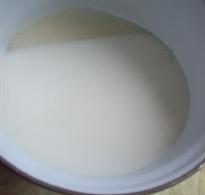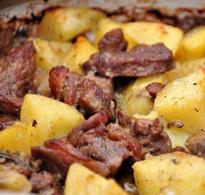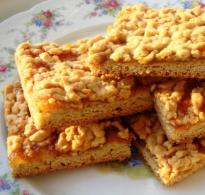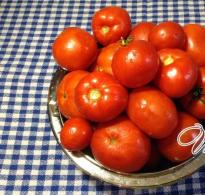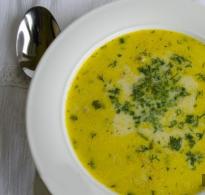Baking powder - what is it, how to use it correctly. How to replace baking powder in baking
Perhaps, any modern housewife knows that you can’t do without baking powder in baking. When baking cakes, Easter cakes and other products from yeast-free dough, this main pledge the fact that the dough will be lush, loose and porous.
For the first time, an analogue of baking powder was invented in the distant 19th century, and in 1903 a rocky pharmacist named August received the first patent for its manufacture. All baking powder can be conditionally divided on views: chemical composition (soda), organic composition (yeast starter cultures) and physical.
For the preparation of confectionery products from flour, it is often used precisely chemical leavening agents. Their principle is the interaction of carbon and ammonia. Among their advantages are the absence of sugars for fermentation and fast action. Those, in turn, are divided into alkaline, alkaline-acid and salt.
Rarely, but a combination of two methods of dough leavening is used (in complex recipes): chemical leavening and yeast or chemical leavening and mechanical processing.
Despite the many types of this product, many housewives have a question, what to do if it is not at hand, and how to replace it? homemade baking powder is no different from the store.
Ingredients can be found in every kitchen. We will need: citric acid, flour (ideally rice) and soda. The ingredients are mixed in a completely dry dish, without a drop of moisture, otherwise they may react prematurely, then the whole effect will disappear.
By interacting with the liquid ingredients of the dough, the baking powder begins to release carbon dioxide, and as a result, the dough becomes airy and fluffy. Basic requirement: do everything quickly until the action of the powder is over and put the pastries in the oven or a warm place, otherwise the dough will settle in the form.
Preferably, the baking powder is introduced into the flour either in the middle of the kneading process or at the very end, when the last part of it is added.
Another alternative could be just drinking soda. If fermented milk ingredients are used in the dough, soda is injected directly into it. If we bake, for example, a butter biscuit, the soda is first quenched with vinegar or lemon juice. If you do all this correctly, there should not be a hint of soda taste in the test.
If honey or chocolate is used in baking, the amount of soda should be reduced significantly. The contents can be mixed easily by simply shaking the vessel, without the use of metal appliances.
It must be remembered that any baking powder increases the initial amount of dough, and calculate the size of the form for the correct proportion, otherwise the dough will simply leak out in the oven.
Homemade baking powder requires proper storage, as in its structure there are no additional production artificial impurity. Experienced housewives keep home-made products in hermetically sealed glass jars in a dark, dry place.
If you put a jar of powder in a damp place, a premature oxidation process may begin, and it will lose its properties. To be safe, you should still mix all the ingredients of the baking powder just before use, then you can be sure that the pastries will not settle at the last moment.
Another lifesaver, in the absence of store-bought powder, is starch. At mixing with soda, it gives such a result, and is prepared in just three stages. First you need to pour about ten teaspoons of starch into a vessel, add five tablespoons of soda, mix thoroughly.
Add three teaspoons of powdered citric acid to the resulting mixture. Stir again. If there is no citric acid on hand, you can replace with lemon or ground cranberries, as they also have a high content of vitamin C.
Some replace the standard powder with alcohol, or combine the two ingredients together. A spoonful of cognac or vodka can also add splendor to the dough. There is no need to worry about the fact that the smell will remain and the children will feel it.
Under the action of high temperature, the smell disappears as well as the characteristic taste.
The main disadvantage of making baking powder at home can be called it high calorie content. The store-bought counterpart contains about 20 fewer calories per serving. Also, it should not be cooked when the hostess is just starting her culinary journey, in this case it is better to trust the finished product.
Some, wanting to play it safe, add a lot of powder to the dough, this should not be done, the baking will not become lush, but may, on the contrary, settle. The taste of such a test will give bitterness and artificiality.
In addition, excess baking powder negatively affects health. Used in high doses, it can leach calcium from the bones and disrupt the gastrointestinal tract.
Housewives note that baking using homemade baking powder always turns out tastier. Perhaps this is so, because every hostess is already set up that made by hand- more natural, which means it will not harm her and her family.
Everyone knows that homemade cakes will never compare with store bought ones. After all, when you cook at home, you are always sure of the quality and origin of the products, you can add as much sugar as you see fit, and also make exactly those cakes or cakes that you love the most.
And in general, women who know how to cook well - there is no price at all, they are always in the spotlight and they are rightfully called good housewives.
That's how it is, but even experienced housewives often run into trouble - the dough will not succeed, or will not grow. And this is really a problem - because when the cake does not rise, then the cake becomes almost "rubber", and then it is very difficult to save it. Neither creams nor impregnations with syrups will all give the desired effect.
What is the problem?
If the dough is yeast - then everything is simple - it is from yeast quality and the friability of the dough depends on whether it rises or not.
What to do when the dough yeast-free? Here the situation looks different. The main component that is responsible for the splendor of the dough is baking powder, in other words - baking powder or baking powder.
Why won't the dough rise?
- The purchased baking powder was stored in the wrong conditions, moisture could get into it.
- An unverified manufacturer of baking powder may have made a mistake in the proportions.
- Baking powder has lost its expiration date.
It is these options that most often become the reason that the dough does not rise. Therefore, you should carefully monitor the expiration date of the baking powder and do not buy several packs in advance. And also buy powder only from reliable trusted companies and check the packing density.
Composition of baking powder
Let's take a closer look at what products are included in the baking powder. Usually this is soda bicarbonate, tartaric acid, to which flour or starch is added in order to avoid moisture ingress into the mixture.
Indeed, it is precisely upon contact with a liquid (water or milk) and late heating that the mixture releases carbon dioxide, which is responsible for the fact that the planned baking will rise and be loose. Of course, if moisture gets into the powder faster, our efforts will go down the drain.
How is baking powder used?
Usually, the manufacturer recommends mixing the required amount of baking powder with flour and adding it to the dough at the end of cooking. If the flour needs to be added gradually, then a piece of flour with powder should be added at the end of the dough kneading.
And do not hesitate - immediately after kneading, you should put the form with the dough in the oven, as the reaction can come faster, and then the dough won't rise again.
How to make baking powder for dough at home
It often happens that we simply forget to buy cookie powder, the guests are almost on the doorstep, and there is no time to run to the store. And a cake baked with one's own hand should certainly be. What then to do?
Do not get upset and do not panic, baking powder can be made and on one's own, moreover, from quite affordable products that are in almost every kitchen.
Our grandmothers also replaced baking powder ordinary soda, extinguishing it with vinegar, and believed that there was no better and more reliable remedy.
However, we all know that it is only a little too much - and the dough will not rise, or it will rise too much and will have a pronounced taste of soda. And of course we don't need that. Therefore, we have selected for you some reliable and proven recipes.
Recipe 1
- 5 parts soda
- 10 parts citric acid
- 12 parts flour
With the help of a kitchen scale, it will be much easier and easier for you to measure the required amount of food. In addition, you can make any amount of baking powder at one time.
However, there are a few tricks here too. The container in which you plan to store your powder should be very clean and dry. Also, such a powder can be stored no longer than three weeks. Therefore, it is better not to prepare a very large portion of baking powder in advance.
Recipe 2
If you can't bear gluten then you'd better prepare your baking powder without flour. The proportions remain the same, but instead of flour, it is better to add corn or potato starch.
Recipe 3
If you want to make baking powder without flour and starch then you should mix soda and citric acid in a ratio of 1:1. In this case, it is better to grind large grains of citric acid in a coffee grinder or grind in a mortar to make the mixture homogeneous.
However, this powder cannot be stored for a long time, and it is better to prepare and immediately use it for its intended purpose.
Homemade baking powder for dough (baking powder)A leavening agent is a substance used to make a food product loose and fluffy. Mainly used for loosening dough.
The composition of the dough baking powder includes soda and ammonium carbonate as essential components.
Baking powders are used to obtain a finished product without the taste of soda. Dough leavening agents are also called baking powder.
If you bake with sourdough, the sourdough is the baking powder. But sometimes other baking is needed (for pies, cookies, cakes, etc.). There is no sourdough there. You need a baking powder.
Most often we use soda slaked with vinegar. But there are subtleties.
Baking soda is used in the preparation of cakes, pastries, cookies and other baked goods, giving them volume. Soda itself is not a baking powder, for this it is necessary to extinguish it with vinegar, while the soda is completely decomposed, and the taste of the product improves.
When soda is extinguished with vinegar, carbon dioxide is released, due to which baking becomes airy and porous. Quick soda does not add volume. But if you put too much soda, a specific unpleasant taste and smell appears. Even if you put not a lot, but as much as you need, everything tastes the same, and you don’t like it.
Experienced cooks never extinguish soda outdoors: carbon dioxide escapes (most of it) without bringing any benefit to the dough. You need to mix soda with flour, and add vinegar or acid to the liquid ingredient included in the dough - kefir, sour cream, eggs.
The most important thing when using soda is to bake the dough immediately, since the reaction passes very quickly, and loosening will not work.
You can also extinguish soda with sour-milk products (without vinegar) - if they are part of the dough, then it is not necessary to add vinegar (sour cream, kefir, whey, yogurt ...).
Cooking recipes now often include baking powder in their ingredient lists. It consists of a mixture of citric acid, soda and flour or starch, which prevent premature quenching. The baking powder does not need to be dissolved, it is mixed with flour and injected into the dough. The reaction in this case begins only during baking, which means that the dough can be left to lie down for a while.
When buying baking powder, remember that the bag in which it is located must not be paper, otherwise the reaction may begin right in the package.
Baking powder can be made at home, it's very easy. This is a great replacement for store-bought baking powder - it works exactly the same.
So,
Recipe for homemade baking powder:
It is better not to do very much, as the baking powder can cake! If you plan to make more baking powder, put a sugar cube in the jar to eliminate moisture.
The composition of the dough baking powder:
Flour 12 parts (flour is added for the convenience of dosing baking powder, manufacturers sometimes use potato starch instead, the shelf life then increases, but at home this is not necessary at all). I take homemade wholemeal flour, you can use wheat, you can take rye.
Soda 5 parts
Citric acid 3 parts. So far, I have prepared baking powder on citric acid, but the thought came that it would be completely replaced by ground dry black or red currants, or cranberries - it is also VERY sour, and at the same time completely natural. I think that then the ground powder of berries should be taken not three parts to 5 parts of soda, but more - at least equally, and maybe even powder of berries more than soda.
Need COMPLETELY DRY!!! a jar with a tight lid, and mix the ingredients with a COMPLETELY DRY spoon - otherwise the reaction will start immediately.
Pour 12 tablespoons of flour into a dry jar, then 5 tablespoons of soda, and at the end add 3 tablespoons of citric acid (or approximately 5-7 tablespoons of dry ground currant or cranberry powder). Then tightly close the jar and shake it well so that all the components are evenly mixed! That's all! This homemade baking powder completely replaces the store-bought one, it rises the dough just as well!
You can add it to any pastry, to pancakes and pancakes (although I generally just bake pancakes with pancakes, without baking powder, but if you need lush pancakes, it’s better to add them).
Store TIGHTLY CLOSED to keep moisture out.
Baking soda
Baking soda acts as a leavening agent in itself, at a temperature of 60 ° C (sodium bicarbonate) begins to decompose into sodium carbonate, carbon dioxide and water.
Baking soda and soda are salts of a very weak and unstable carbonic acid, so they react with stronger acids to release carbon dioxide. The dough usually has a slight acidity (caused by dairy products), but to enhance the effect, flour is often pre-mixed with citric acid (dry), or by adding tartaric acid (poor acetic acid) to the liquid.
A mixture of soda, citric acid and flour is sometimes sold under the name of baking powder.
It is widely believed that baking soda and vinegar should be mixed before adding to the dough. This is completely useless, since the reaction takes place outside the dough, carbon dioxide escapes before cooking begins. The gas formation reaction starts immediately when kneading, it is important to put it immediately in the oven when the dough is heated - the reaction accelerates, the bubbles expand and repeatedly raise the dough.
ammonium carbonate
Unlike baking soda, ammonium carbonate completely decomposes into gaseous components, leaving no mineral salts and adding nothing to the taste of baked goods.
It can be used in a non-strict dosage, since in any case the whole will fall apart. In addition, it releases more gases. The only drawback is the instability in air during long-term storage. It is the main component of baking powders.
***
In dough baking powder, there may be one or several different acids. Russian manufacturers, as a rule, use traditional citric acid in such powders, imported baking powders may contain several different acids, this is done so that at any temperature of the liquid that is necessary for preparing the dough, the baking powder in any case fulfills its functions. Since different acids react with baking soda at different temperatures. In the role of a filler, in most cases, manufacturers use baking flour, less often, in some cases, starch.
Occasionally there are such culinary recipes, which may include both baking powder and baking soda. This is done to ensure that the reaction goes exactly without a trace. The fact is that if the selected recipe includes rather acidic foods, then you simply cannot do without adding ordinary soda. A product with high acidity can include: any fruit puree or juice, citric acid in crystals, sugar syrup, eggs, vinegar, chocolate, honey, cocoa, as well as almost all fermented milk products: yogurt, yogurt, sour cream, whey, kefir etc.
It would be wrong not to say that the replacement of soda with baking powder is far from always justified. For example, if honey is present in the recipe, then soda is simply necessary in it.
Based on articles.
Do you decide to bake buns for Sunday dinner or birthday cake layers, or maybe you want to please your family with lush cupcakes? In all these cases, baking powder will come in handy. It will also come in handy if you don't like the smell and taste of yeast in baking, or don't have enough eggs on hand for the recipe. What is this magical powder?
A bit of history
The history of the emergence and use of powder as an integral ingredient for baking cakes, pastries and even bread dates back to the beginning of the 20th century. Baking powder is believed to have been invented by a Briton named Alfred Byrd as early as 1843. But it was not he who received the first commercial patent, but the German pharmacist August Oetker, who at the beginning of the 20th century founded a company engaged in the production of the same powder and other products useful for baking. He accurately measured the components necessary for loosening, calculating them for 500 g of flour. Until now, the products of this particular manufacturer are considered the best on the European market. However, more than 100 years have passed, and the recipe has undergone many changes. Various companies, striving for the manufacture of unique products, changed the proportions and added new components. Baking powder has gained great popularity among ordinary housewives. After all, they sought to make their pastries as airy and soft as possible.
What is baking powder

How to replace baking powder

Sometimes the idea to bake something tasty comes suddenly, and it turns out that it is baking powder that is missing from the kitchen. How to replace it in this case? As mentioned earlier, such a powder is a mixture of soda and acid, as well as an element that prevents them from reacting in vain. Therefore, you can safely use soda, which is usually always in any kitchen, and citric acid. Mix them dry in equal proportions and add the same amount of flour, starch or powdered sugar to them, and then follow the chosen recipe. You can prepare baking powder for future use, but it should be stored in a dark place in a glass container without moisture and air, otherwise it will lose its properties. When adding to the dough, mix it only with dry ingredients.
Store-bought baking powder (baking powder) is a mixture of soda, citric acid and flour (starch). It fills the dough with carbon dioxide and makes pastries fluffy.
Carbon dioxide is released due to the interaction of soda and acid. In order for them to react completely and in a timely manner, they are mixed in a ratio of 5: 3: 12 (soda: citric acid: flour or starch).
Baking powder substitutes are designed to repeat this reaction, fill the dough with carbon dioxide, or simply make it more friable.
For reference... 10-12 g of baking powder is placed in one teaspoon, the same amount in a standard bag. If you have to translate the rest of the ingredients, Lifehacker will help.
How to replace baking powder
recept-menu.ru- What test is suitable for: butter, biscuit, custard or.
- How to replace: 1 teaspoon baking powder = 1 teaspoon homemade baking powder.
- Where to add: in flour.
Take 5 tablespoons of baking soda, 3 tablespoons of citric acid, and 12 tablespoons of flour or cornstarch. Pour all the ingredients into a dry glass jar and gently mix with a wooden stick.
The jar and spoons must be absolutely dry, and the stick must be wooden. Moisture and stirring with a metal spoon may cause the reaction to start prematurely.
 xcook.info
xcook.info - What test is suitable for: butter, biscuit, custard or shortbread, if the composition contains acidic foods.
- How to replace: 1 teaspoon baking powder = 1 teaspoon baking soda.
- Where to add: in flour.
Baking soda itself is a baking powder. At temperatures above 60 ° C, it releases some carbon dioxide.
Quick soda in its pure form can be added to the dough, where there are already acidic foods. For example, sour cream, kefir, fruit puree or juice.
 static.relax.ua
static.relax.ua - What test is suitable for: butter, biscuit, custard, shortbread.
- How to replace: 1 teaspoon baking powder = ½ teaspoon baking soda + ¼ teaspoon table vinegar.
- Where to add: soda - to dry ingredients, vinegar - to liquid or slaked soda - to the finished dough.
Undecomposed soda gives baked goods a yellow-brown or greenish tint and an unpleasant aftertaste. Therefore, if there are no acidic ingredients in the recipe, it must be quenched with vinegar.
It is important to introduce slaked soda quickly, without waiting for the end of bubbling, so that carbon dioxide does not have time to escape.
The dough with baking powder can stand. The dough with slaked soda needs to be baked right there, since the reaction is already running.
But it is better to mix soda with dry ingredients, and vinegar with liquid ones. Then the interaction will begin after kneading the dough.
 liveinternet.ru
liveinternet.ru - What test is suitable for: shortbread without yeast, .
- How to replace: 1 tablespoon of alcohol per 1 kg of dough. The mass of the future test is equal to the mass of all ingredients.
- When to add: can be poured into liquid ingredients or mixed into flour.
Alcohol adds airiness to baked goods, as it reduces the stickiness of the flour. Cognac and rum do an excellent job of loosening yeast-free shortcrust pastry. In addition, these drinks leave behind a pleasant aroma.
Vodka is added to yeast dough, especially if it is on a dough, so that it rises better.
 xcook.info
xcook.info - What test is suitable for: rich, unleavened, custard and other dough that is cooked on water.
- How to replace: forget about baking powder, replace non-carbonated water in the recipe with sparkling water.
- When to add: on prescription.
Highly carbonated mineral water can also saturate the dough with carbon dioxide. For greater effect, you can add a pinch of salt and citric acid to it.
When Not to Replace Baking Powder
 testoved.com
testoved.com The composition of the classic biscuit often includes baking powder. But if neither it nor soda is at hand, you can do without them. After all, there are eggs - the role of baking powder may well be played by squirrels whipped into a strong foam.
It is important to achieve airy foam and carefully, with movements from the bottom up, introduce it into the dough so as not to destroy the bubbles. The finished dough must be immediately sent to the oven, otherwise it will settle.

